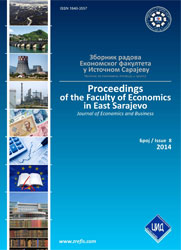KRITIČKI OSVRT NA PRIMENU MYERS-COHN-OVOG MODELA ZA ODREĐIVANJE MARGINE PROFITA U NEŽIVOTNOM OSIGURANJU
THE CRITICAL OUTLOOK ON THE APPLICATION OF THE MYERS-COHN MODEL FOR DETERMINING A MARGIN PROFIT IN NON-LIFE INSURANCE
Author(s): Mirela MitraševićSubject(s): Economy
Published by: Ekonomski fakultet Pale - Univerzitet u Istočnom Sarajevu
Keywords: solvency, profitability, a profit margin, the allocation of capital
Summary/Abstract: Determining a margin profit in an individual type of insurance presents one of the problems that actuarial science has been trying to solve for some time. A profit margin is determined by the price of capital allocated to an individual type of insurance. Determining a profit margin is conditioned by how much capital is needed to decrease the uncertainty of the insurance results and by how long capital needs to be tied to an individual type of insurance. The insurer must secure the legal solvency margin and at the same time he must meet the requirements of his shareholders by making it possible for a share price to go up. Unless a satisfactory profitability is secured and unless a product price makes up for the slow increase in the price of capital, shareholders will be less interested in investing into an insurance company. Therefore, it is essential to consider the ways in which to allocate to individual types of insurance the costs of having one’s own capital. Several financial models were developed in order to determine a profit margin. This paper presents the Myers-Cohn model of a discounted cash flow.
Journal: Zbornik radova Ekonomskog fakulteta u Istočnom Sarajevu
- Issue Year: 2014
- Issue No: 8
- Page Range: 237-245
- Page Count: 9
- Language: Serbian

